Leycesteria formosa
Himalayan honeysuckle, Leycesteria formosa, is just as beautiful as all the other types of honeysuckle plants, yet offers its own unique appeal.
L. formosa can be grown as a vine or a shrub, and it produces sweet-smelling white flowers that descend from scarlet or purple bracts.
These flowers bloom in the late spring through summer. In fall, plants produce berries with a noteworthy flavor similar to that of caramel or toffee.
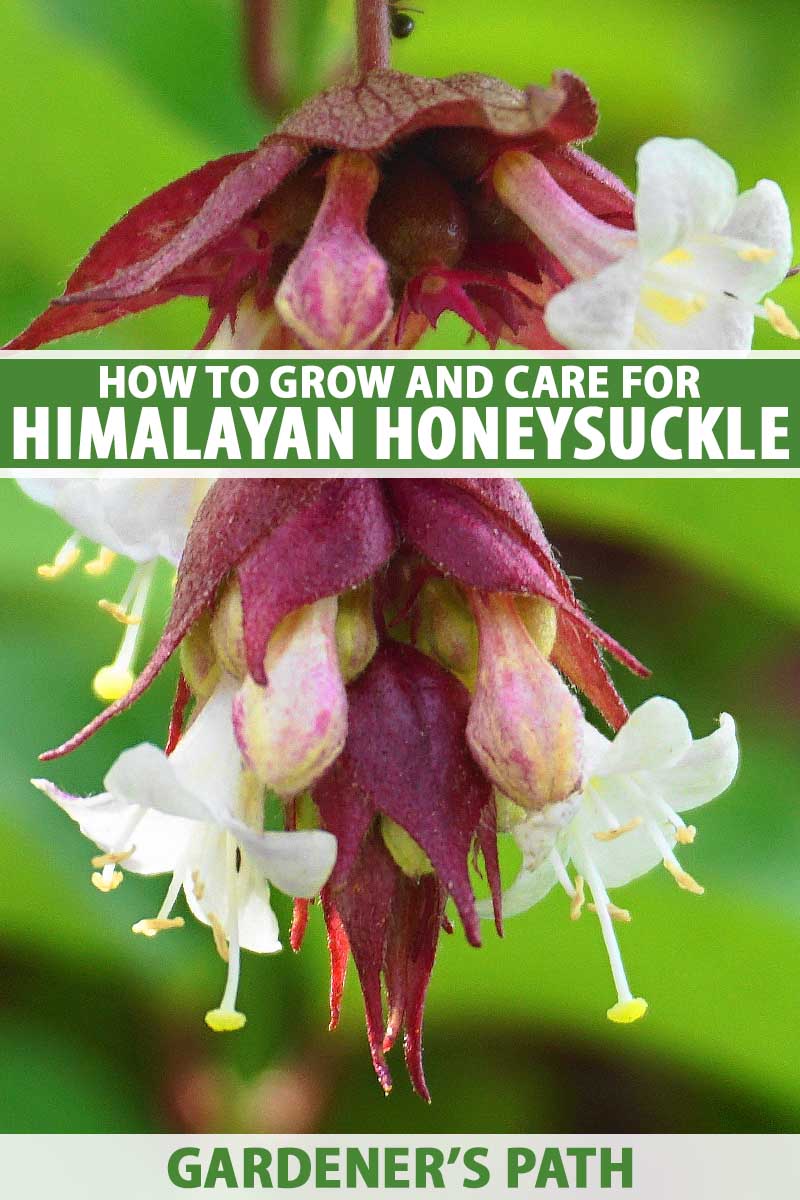
We link to vendors to help you find relevant products. If you buy from one of our links, we may earn a commission.
Though similar to other honeysuckle plants in the Caprifoliaceae family, Himalayan honeysuckle offers notable differences in terms of its low-maintenance appeal as well as its visual appearance.
What really makes these plants so special is their origin, they come from the Himalayas – which means lots of chilly nights are required to help keep them healthy.
If you’re interested in learning more about what conditions contribute to a good life for the beautiful Himalayan honeysuckle, here’s what I’ll cover:
What You’ll Learn
What Is Himalayan Honeysuckle?
As its common name might suggest, L. formosa is native to the Himalayas in Asia.
It is frequently regarded as a noxious weed in places like Australia and New Zealand, but fortunately, it can easily be controlled by gardeners who wish to grow it in North America.
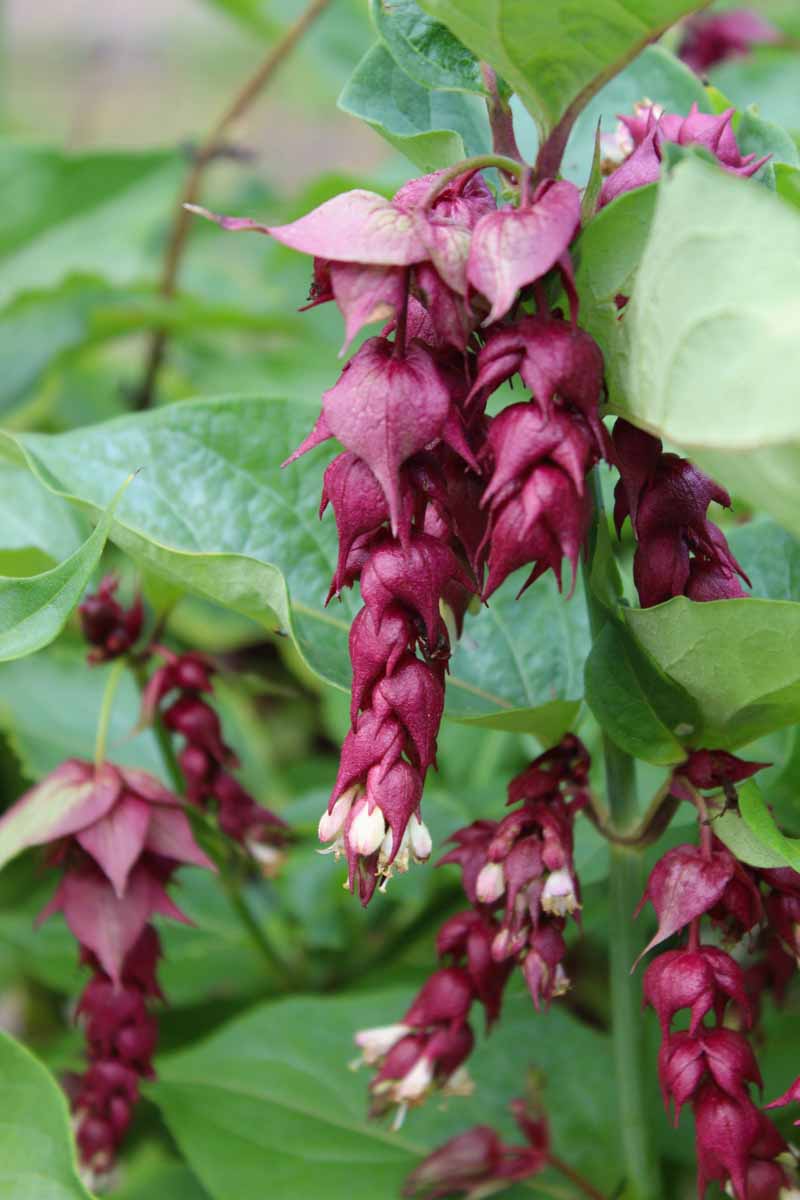
It grows rapidly and is adaptable to many garden conditions, and as such, it is considered invasive today in some areas.
If you are worried about its ability to spread, consider isolating this plant in one area of the garden, away from other plants that might not be able to hold their own.
You can always grow it in a container or create divisions on a regular basis to control its spread.
Otherwise, beyond the potential need to keep it in check, there’s lots to enjoy about this shrub!
It produces arching stems that begin to flower in the late spring or early summer and grows to about three to six feet tall and wide.
Its upright, hollow stems are gray in color and clad with dark green leaves, each of which is about two to seven inches long.

The small flowers (usually white) generally endure until fall and are followed by tiny purple, edible berries that are prized for their flavor.
Of course, you can’t overlook the beauty of this plant’s colorful bracts, either. These are a deep purple, sometimes dark scarlet, and are often even more captivating to behold than the flowers themselves.
This plant goes by many other names, though Himalayan honeysuckle is of course one of the most common.
Other names for L. formosa include pheasant-eye and pheasant berry, named as such because pheasants love to eat the tasty fruits. You may also hear the shrub referred to as flowering nutmeg or granny’s curls.
Cultivation and History
Though native to the Himalayas, L. formosa is now naturalized in the wild in southern England.
Its generic common name was first coined in 1820 by Nathaniel Wallich, former director of the Calcutta Botanic Garden. He chose “Leycesteria” in honor of his good friend William Leycester, who was then a judge in Bengal.
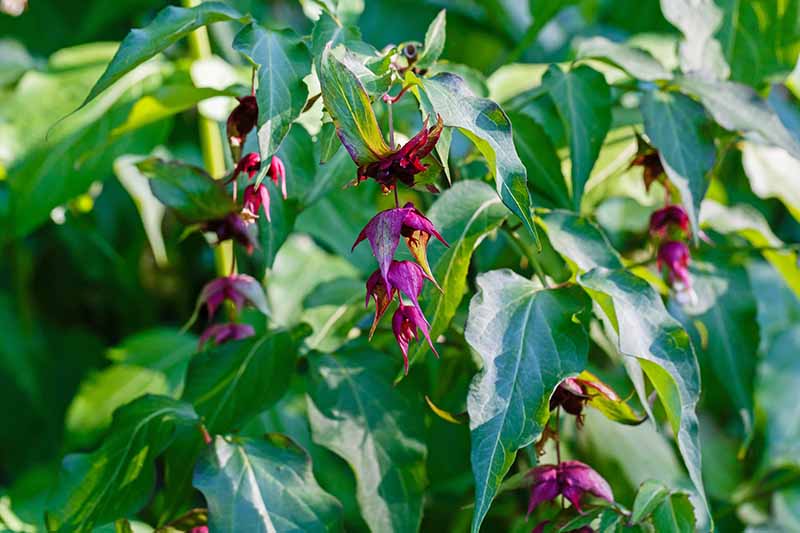
In Latin, the scientific name also pays homage to the plant’s appearance, with “formosa” translating roughly to “beautiful.”
Himalayan honeysuckle is winter hardy in USDA Hardiness Zones 7-9.
Propagation
Himalayan honeysuckle can be propagated by seed as well as from softwood cuttings.
From Seed
If you can, purchase seeds that have already been cold stratified for several months.
You do not need any supplemental heat when germinating your seeds. Instead, just sow seeds into a tray of moist seed starting mixture in the fall, and cover them to their own depth (1/8 inch or so) with sand.
If you did not purchase seeds that were already cold stratified, keep the tray in a cool location that is around 40 to 50°F, and maintain even moisture.
Seeds almost always germinate in the spring regardless of when they were sown, but this period of cool temperatures helps to increase germination rates.
From Stem Cuttings
If you choose to propagate cuttings, you can take softwood cuttings of about four inches in length in the summer.
Make a cut just below the node where one or two leaves attach to the stem. Remove any flowers, and remove any leaves from the lower half of the cuttings.
Any kind of well-draining potting mixture can be used in a container that is at least four to five inches deep. If planting multiple cuttings, provide at least six inches of space between them in a large container, or give each its own pot.
Dip the base of each cutting in a rooting hormone product. Then, use your finger or a pencil to make a hole about two inches deep in the growing medium.
Place the cutting in the hole, then firm the growing medium around the stem. Water and allow it to drain.
Keep them indoors in a location that receives bright, indirect sunlight. Check them daily and remoisten the medium when it starts to dry out on the surface.
The soil should feel moist to a depth of at least two inches. Your cuttings should have roots within six to eight weeks.
Once the roots have developed, you may transplant cuttings to the garden in the fall.
From Seedlings/Transplanting
To transplant your seedlings or rooted stem cuttings, dig a hole that is just as deep and twice as wide as the root ball of your plant. Remove the plant from its pot and gently loosen the roots before placing it in the soil.
The top of the root ball should be slightly higher than the soil line. When you bury the roots, create a slight mound. This will allow water to drain away from the base so that it does not become waterlogged.
Firm the soil around the plant, then water deeply.
If you wish to grow multiple plants, space them about two to three feet apart. This will allow you to form a hedge or border without overcrowding the plants.
How to Grow
L. formosa enjoys a full sun location, but note that a bit of afternoon shade is desirable in warmer areas.
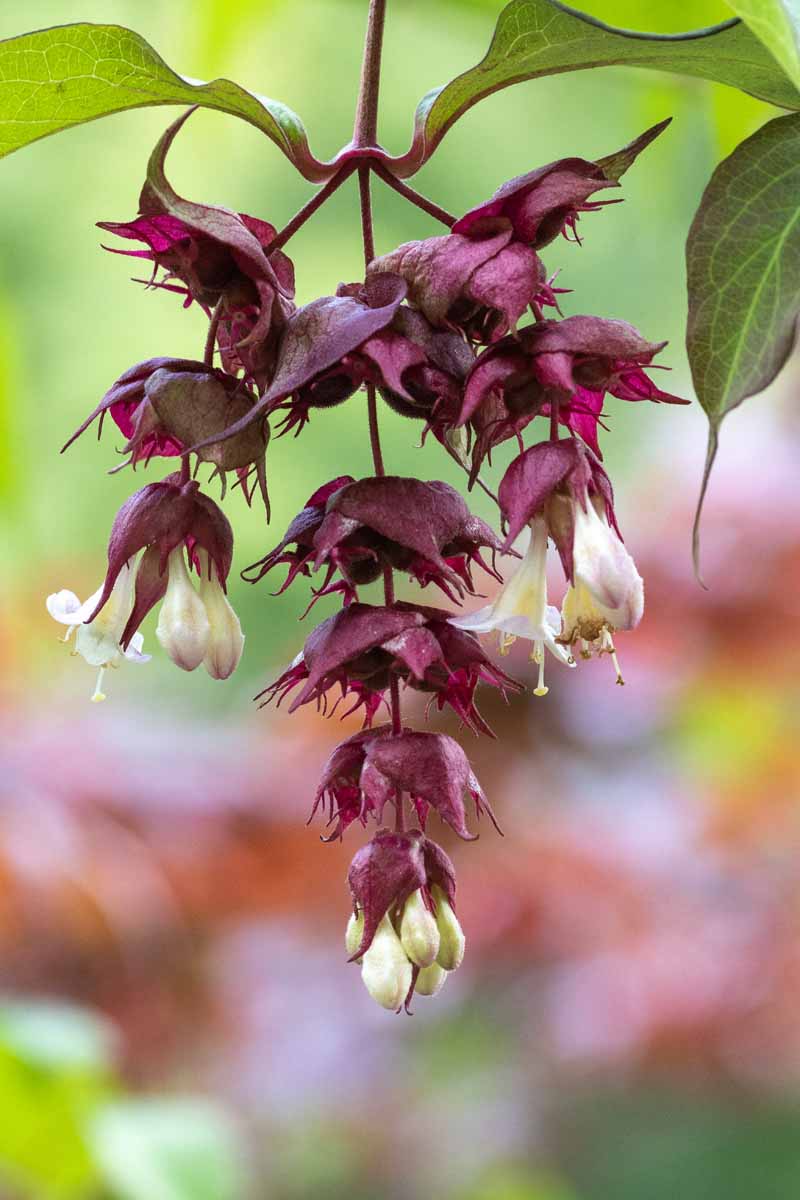
This is a low-maintenance plant, requiring only occasional water in dry periods once established. In the first two years after transplanting it should be watered regularly in the absence of rain, receiving about an inch of water per week.
If winter temperatures regularly dip below 15°F, the stems of this shrub will freeze to the ground. Fortunately, new ones will sprout in spring as long as the roots are protected, and grow back quickly by summer. They’ll often put on several feet of growth by this time.
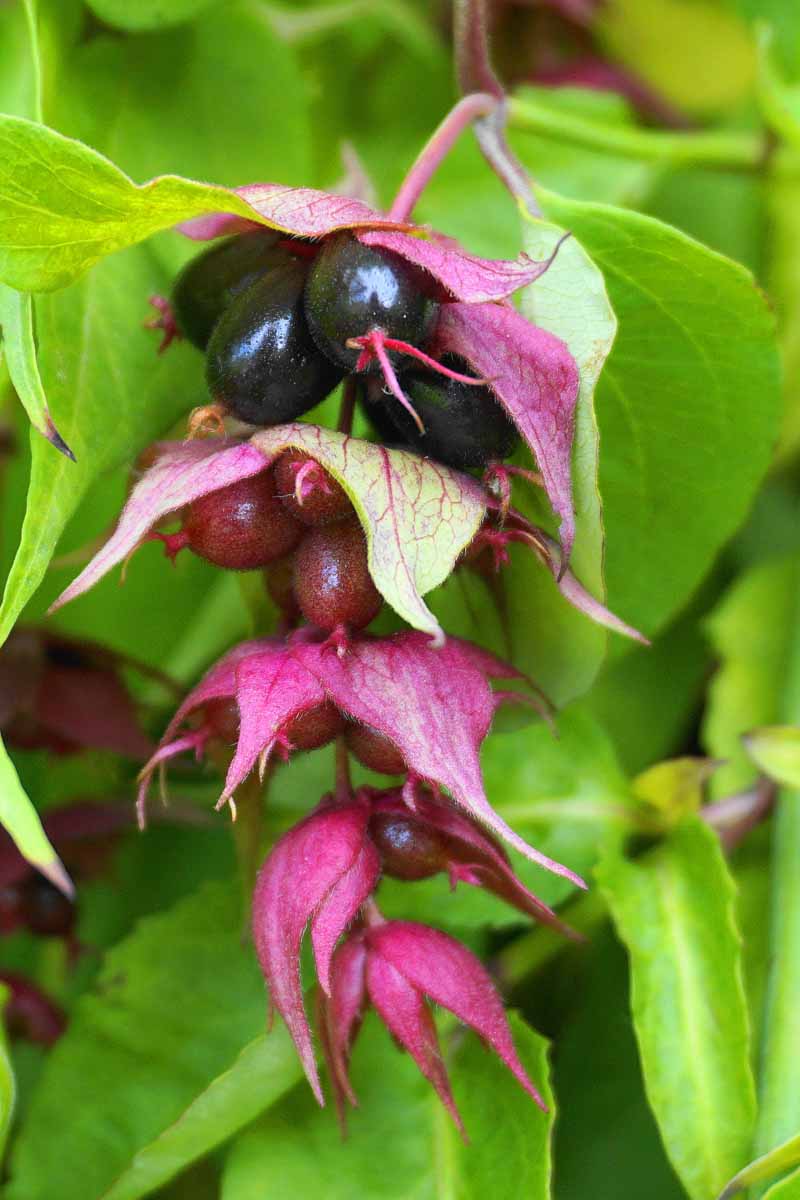
L. formosa grows best in average, well-drained soil. This undemanding plant can grow in nutritionally poor soils and it tolerates everything from sand to clay, and a pH range of 6.0 to 8.0.
As long as the soil is kept moist while it is becoming established, this plant does not require a lot of attention.
If you wish to fertilize, you can add a side dressing of compost in the fall or spring. Again, this is not necessary but can be done if your soil is exceptionally poor.
You can apply a thick, two to three-inch layer of mulch for the winter if you live in an area that is near the northern edge of the suitable growing range or an area that is prone to particularly cold winters. This will help protect the root system.
Growing Tips
- Plant in well-draining soil in a full sun location.
- Water deeply during dry spells.
- Mulch in the fall for winter protection.
Pruning and Maintenance
Your plant can be cut back to within just a few inches of the ground in the late winter or early spring, when plants are dormant.
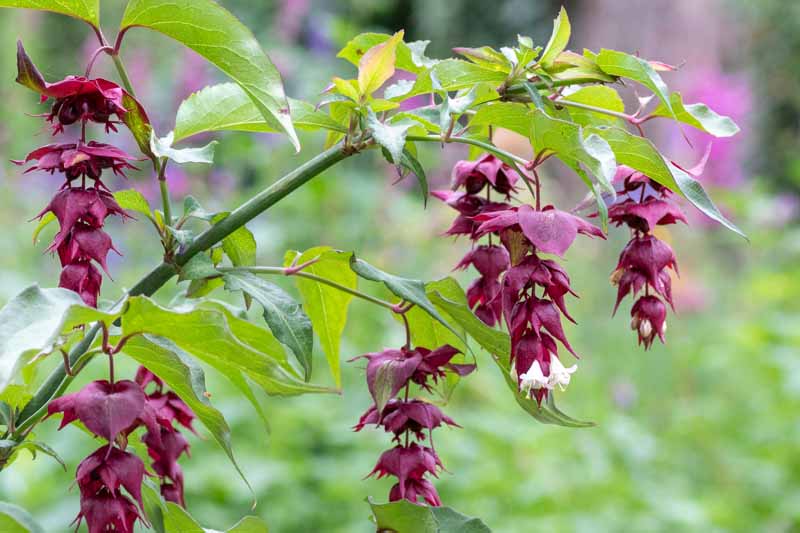
Although it is not necessary for the health of the plant, this kind of hard pruning can help control its size and limit its spread in your garden. It can also revitalize the plant’s appearance, especially if you remove any weak, twiggy growth.
Flowers appear on new growth, so do not worry about heavy pruning affecting your blooms.
Cultivars to Select
There are few cultivars of Himalayan honeysuckle available for gardeners to choose from, but as the plant rises in popularity, more options are being created by breeders.

You can purchase seeds to start your own L. formosa plants via Amazon.
Golden Lanterns
L. formosa ‘Golden Lanterns’ is a popular cultivar that has all the attractive features of the parent species, but with a unique twist. Its new growth is tinted in amber and its foliage is more yellow than it is green.
It blooms a bit later in the season, too, often flowering until October. It grows to about six feet tall and four feet wide at maturity.
It is a bit more cold-hardy than the species plant as well, suitable for Zones 6-9.
Jealousy
‘Jealousy’ is another cultivar to consider. This one also grows in an upright fashion with yellowish leaves that turn purple in the fall.
It is hardy in Zones 7-9 and offers all the appeal of other kinds of Himalayan honeysuckle. It grows a bit more slowly, often taking up to ten years to reach its full size of six feet tall and three to four feet wide.
This makes it a good option for gardeners who want to control its spread.
Managing Pests and Disease
The Himalayan honeysuckle is a unique shrub in that it is generally considered pest- and disease-free.
This is in contrast to other kinds of honeysuckle plants in the Caprifoliaceae family that tend to be vulnerable to pests and diseases like potato aphids, leaf blight, and diaporthe stem canker.
Best Uses
There are countless ways you can incorporate L. formosa in your landscape.
It looks wonderful in an informal cottage garden, as well as in perennial beds composed of other drought-tolerant plants. It can also be cultivated to form a border or hedge.
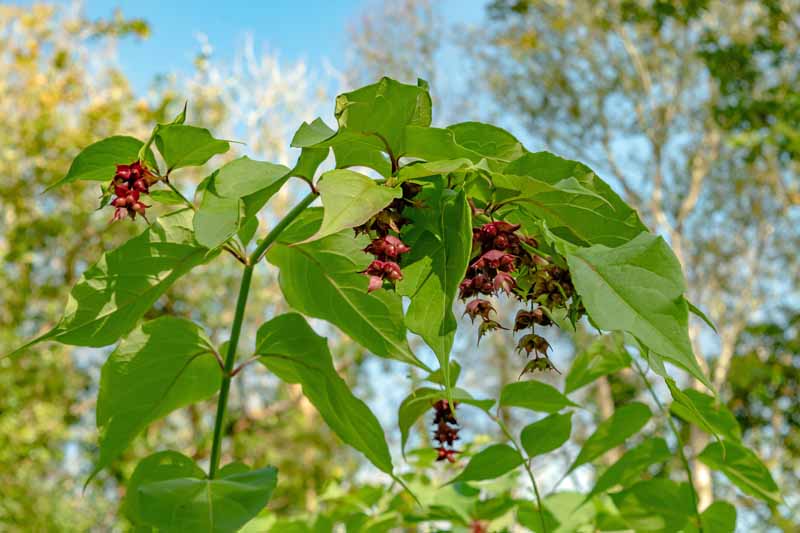
In warmer areas, where growing in a bit of shade is ideal, it can also be incorporated into a woodland garden.
And don’t forget the appeal of its edible berries, both for yourself and for attracting birds of all kinds. Hummingbirds, finches, blackbirds, pheasants, thrushes, and many other types of birds all appreciate Himalayan honeysuckle.
Of course, the birds may get to those berries first, and that’s just a risk you’ll have to take. Many gardeners choose to harvest the berries to use in their cooking if they’re able to save any.
They have a toffee- or caramel-like flavor so are wonderful in desserts, such as tarts and pies.
Do be gentle when harvesting the berries, however, as they are soft and easily damaged. In fact, this is how you can tell they are ripe. If they burst at the slightest pressure from your fingertips, they are ready to be harvested.
Quick Reference Growing Guide
| Plant Type: | Woody shrub | Flower / Foliage Color: | White with purple bracts/green |
| Native to: | Himalayas | Maintenance: | Low |
| Hardiness (USDA Zone): | 7-9 | Tolerance: | Cold hardy once mature |
| Bloom Time: | June to September | Soil Type: | Average |
| Exposure: | Full to partial sun | Soil pH: | 6.0-8.0 |
| Spacing: | 2-3 feet | Soil Drainage: | Well-draining |
| Planting Depth: | Depth of root ball (transplants), 1/8 inch (seeds) | Attracts: | Hummingbirds |
| Height: | 6 feet | Uses: | Cottage garden, borders, woodland garden, edible berries |
| Spread: | 6 feet | Family: | Caprifoliaceae |
| Time to Maturity: | 5-7 years | Genus: | Leycesteria |
| Water Needs: | Low, when established | Species: | Formosa |
Super Sweet Berries and Hummingbirds for Days
A perennial shrub, L. formosa is easy to grow and simple to care for. Although it does take some time for the seed to germinate (and you’ll need to be mindful of the plant’s ability to spread and sprawl), you should find that growing this plant is not challenging.
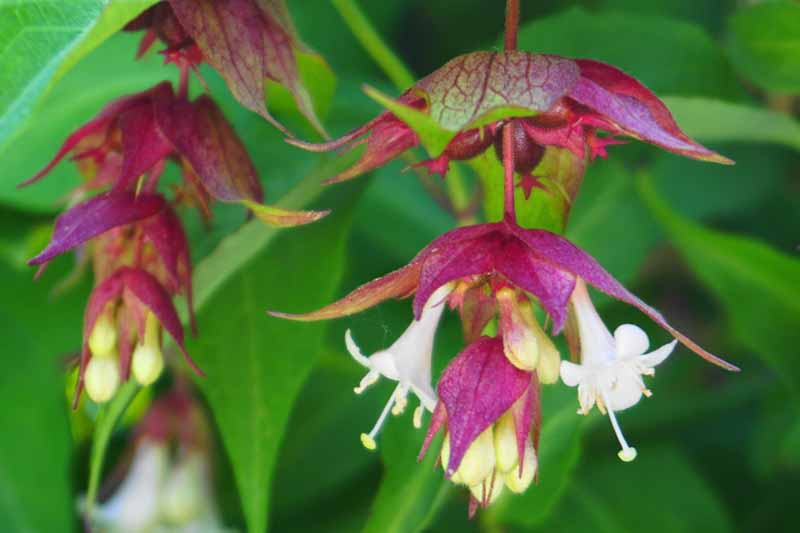
After all, it has virtually zero pest and disease problems to worry about and requires little care besides the occasional splash of water.
If you’re ready to grow an attractive plant that will attract hordes of hummingbirds to your garden, L. formosa is one to consider.
Are you growing Himalayan honeysuckle? Let us know in the comments section below!
And for more information about growing flowering shrubs in your garden, have a look at these guides next:

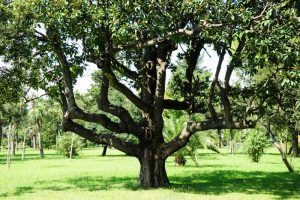
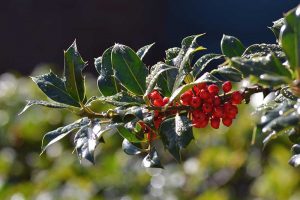
I’m lucky enough to have a self seeded Himalayan honeysuckle in my garden, in southern England. Will give it a prune back to ground next March and enjoy watching it grow & flower again next year – the bees love it.
This sounds lovely, John. Thanks for sharing.
We moved 9 years ago and I was given one. It is now at maturity and beautiful… what is lovely is seeing the blackbirds jumping up to get them. Wonderful sight. Didn’t know we could eat them, but as you say, if we get a chance. From South Yorkshire, England
I’m in South Yorkshire too and was given a cutting last autumn which rooted well. It’s now in a large pot and is 2 feet tall with flowers plus berries which I was afraid to eat but having read the info I may give them a try.
I was given a Himalayan honeysuckle several years ago and it blooms every year and I have got several plants around the garden now thanks to the birds! I’m in Gloucestershire, UK. I too wasn’t aware the berries are edible, and as I love toffee/caramel, no doubt I will be giving them a try !!
Hello Sandra Pember! Let us know what you think now that we’re in a new season for Himalayan honeysuckle.
I have been wondering what this plant is. I’m in Northeast Scotland. The plant just emerged from a neglected clay pot with old soil in it. I wondered if it was something I shouldn’t keep in case a pest of some sort but as it developed and produced its attractive flowers I started wondering who to ask about it. It is still in flower last time I looked in my sheltered lane. November seems late by other accounts?
What a lovely find! Are you sure this is the species that you found growing in the old soil, and can you send photos? Himalayan honeysuckle typically blooms between late spring and early fall.
My daughter gave me a pot with around 15 seedlings in which had sat under another bush, which we now know as a Himalayan honeysuckle. I potted the seedlings and give them to friends, I have a couple in the garden and planted a few in my hedge last year to see what happens as they grow. Mid last year my wife and me went to a couple of garden centers and found a couple for sale around 3ft tall. £ 60:00 each and to think I give them away. We are into January and mine are still in flower… Read more »
My Golden Lanterns last summer was a beauty at 5 ft. tall, planted in a 3.5 ft. diameter bottomless pot. There were several weeks of freezing weather this past winter and the old trimmed branches look black/dead. My growing zone is 8. When are new shoots expected to emerge? Should I just hope for seedlings to show up?
mk/Apr 2022????????
Sorry for our delayed response, Mary! It sounds like your plant suffered cold damage over the winter, which is not uncommon for plants grown in pots. Containers do not retain warmth like the ground, and potted plants may require additional protection through the winter, or relocation to a protected area until the return of spring. Dieback due to frost damage is not always an indication that plants are dead, and there may still be activity at the roots and crown. I hope you’ve seen signs of life in the months since you were in touch!
Hi one if these appeared in my garden. I didn’t know what it was or how to look after it so unfortunately it has grown into a ‘tree’ like plant about 4 feet. The main stem is very woody and the branches only start about 2 feet up the main stem. Should I cut it right to the ground as suggested?
Are you 100% certain that your mystery plant is Himalayan honeysuckle, Alison? Please feel free to share photos, if you’re able to. These plants grow very quickly with an upright growth habit and they can attain a height of about 6 feet- this sounds like a healthy specimen to me! Cutting it down at this time of year is not recommended – it’s best to do any hard pruning after plants die back with the arrival of first frost, as they go into dormancy. If you wish to prevent unwanted spread, you may want to deadhead by trimming back the… Read more »
My daughter has one of these when she moved to a house with a rather neglected garden. It is about 5feet tall with very woody thick stem – it has obviously not been pruned. However it is right at the front of a border on the drive and she wants to move it back against the wall. Will it survive moving and pruning and when is best time to do this?
Fortunately these plants generally respond well to hard pruning. As long as the plant is otherwise healthy, it can be trimmed back as described above nearly to the ground when it is dormant in the winter, or shaped and cut back as desired, and it should put on new growth the following spring. I would avoid transplanting and pruning significantly in the same season, to avoid stressing the plant. What your daughter might like to do is prune this year in late winter, and wait to see how much growth it puts on throughout the next growing season. Regular annual… Read more »
I’m over the moon, just learned I have Himalayan honeysuckle plant growing.
Fantastic! Feel free to share photos if you like, Donna!
One just appeared in my garden it’s now about 4 foot high with beautiful flowers it was obviously self seeded. Only found out today what it was….
What a lovely surprise, David King! If you are able, keep us posted on its progress.